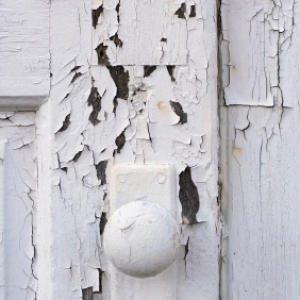If you’re home was built on or before 1978, there’s a good chance that the home has lead-based paint. It’s important you know this before doing any home projects, because breathing in lead dust or accidentally ingesting lead chips can lead to a myriad of health problems for children and adults, including nerve and kidney damage, developmental disorders, digestive disorders, muscle and joint pain, and memory problems. If you have to do a big home project, we recommend that you have professionals remove the old paint. However, if you have no other choice, make sure you take all the appropriate precautions to prevent lead poisoning. Here are 5 tips for handling lead-based paint:
- Prepare the Area. If you’re working indoors, remove everything from the subject room that you can. Cover all flooring with disposable protective sheeting (you won’t be using it again) and tape it to the baseboard. Also, cover any remaining furniture with protective sheeting. If possible, seal off the room by covering the doorway with plastic. Wear non-skid shoe covers, or clean off shoes with a wet rag or tacky pad before leaving the room. The main goal is to prevent all lead paint dust from being tracked anywhere else in the home.If you’re working outdoors, lay down protective sheeting at least 10 feet out from the work area (if on the first floor) and 20 feet (if working on the second floor). Leave all windows and doors within 20 feet closed. If you need to use a door close-by, shroud it on the top and all sides. If there is a sidewalk or an area accessed by the public, make sure put up a barrier and warning sign (“Lead Paint: No Eating, Drinking, or Smoking”).
- Dress in Appropriate Clothing. Cover yourself well, including your head. Wear old clothes and paint suits. If they’re torn, repair them with duct tape. You can reuse the paint suits if they’re fairly clean, but store them in a garbage bag. Work clothing should be dusted off and washed separately from other clothing. While working, use a respiratory mask approved for use with lead-based paint and wash your hands every time you take a break.
- Use the Most Appropriate Method of Removal. Whichever method you choose depends on the surface you are working on. Thoroughly research this beforehand. Chemical strippers are often used. Wet scraping is another option, but not as effective. But try to avoid any sanding (it creates excess dust that can be breathed in) and heat (it creates toxic fumes).
- Clean Up Thoroughly. Pick up large paint chips with a damp towel. Mist any dust with water before sweeping it up. Dust off protective sheets. Fold them inward to prevent spreading dust. Vacuum all horizontal surfaces, including the floor, ledges, molding, etc. Wet and scrub (not just wipe) all surfaces that you can. Wring out the water in a separate tub. Make sure you get in every nook a cranny.
- Dispose of Debris Safely. Put debris in a dumpster and keep it covered. Never carry debris through an occupied space without covering it in a plastic tarp. Pour all dirty water into th
 e toilet (NOT the sink, bathtub, storm drain, or ground). For more information, read this brochure from the U.S. Department of Housing and Urban Development.
e toilet (NOT the sink, bathtub, storm drain, or ground). For more information, read this brochure from the U.S. Department of Housing and Urban Development.
If you would like a recommendation for a good painter or contractor in the Wilmington area, you are always welcome to call The Cameron Team. We are happy to give you the name and number of someone we have worked with in the past. Just call us at 910.202.2546 or visit our Contact page. Good luck!


